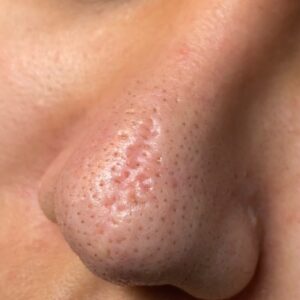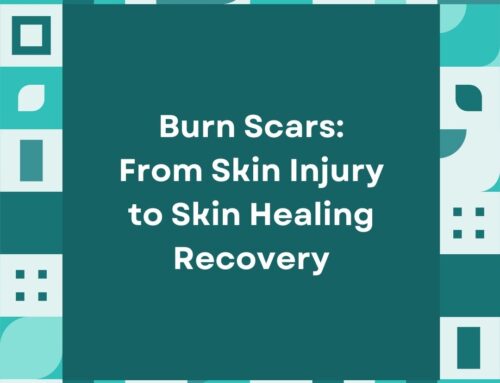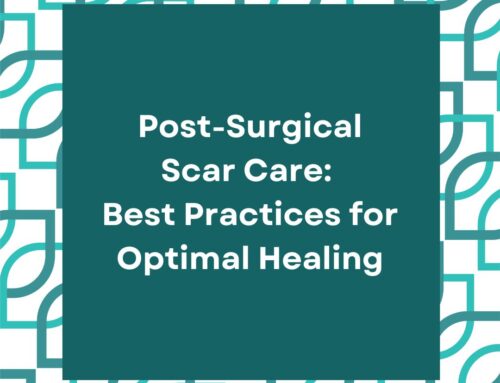In our recent blog posts, we focused extensively on the causes and treatment options for atrophic scarring, also known as depressed scarring. Today, we will shift our attention from atrophic acne scarring to its counterpart: hypertrophic scarring.
What are hypertrophic scars?
Hypertrophic scars are uniquely characterized by their raised, thickened appearance and arise from a variety of causes, including lacerations, trauma, surgery, and acne.
Their protruding appearance is caused by the overproduction of collagen during the wound healing process. Early-stage hypertrophic scars may initially appear red or pink and can slowly lighten or darken with time.
Hypertrophic scars can be particularly distressing to individuals, especially when these scars appear on visible areas of the face and body.
They can also limit mobility if these scars fall on mobile joints, such as the shoulder, elbows, or knees. Patients who suffer from hypertrophic scars need to seek early intervention to prevent their scars from causing long-term cosmetic and functional issues.
When do hypertrophic scars form?
Not everyone is predisposed to develop hypertrophic scars. People of non-Caucasian descent, for instance, are at a greater risk for observing hypertrophic scarring.
Nevertheless, those that do have a predilection for scarring will start to see them within weeks of the original injury. It is important to keep in mind, however, that hypertrophic scars can form in a more delayed fashion, sometimes even months after the initial injury.
Factors, such as skin genetics, body location, and overall wound management can greatly affect the odds of hypertrophic scar formation.
What is the difference between hypertrophic scars and keloid scars?
Many believe that hypertrophic scars and keloid scars are synonymous. A more precise distinction is that keloid scars are a subtype of hypertrophic scars.
Keloid scars are raised just like hypertrophic scars but are unique in that they continually grow beyond the borders of the original wound. In fact, many keloid scars start off as simple hypertrophic scars but evolve due to a myriad of different factors.
This is another reason why it is imperative to act quickly when you observe any sign of hypertrophic scar formation.
Are hypertrophic scars permanent?
As with all types of raised or depressed scarring, hypertrophic scars are permanent. Because they arise from altered collagen synthesis and remodeling, the raised, firm scar tissue you see will never completely go away. However, there are many different types of non-invasive treatment available that can help flatten your hypertrophic scar (read below).
Does hypertrophic scarring go away on its own?
Most hypertrophic scars will fade to a certain extent on their own. It also really depends on what stage of healing your wound is in. In fact, many individuals confuse ongoing early-stage inflammation with scarring.
The redness and swelling may give the appearance of scarring but will need to completely settle before the final scar can be observed.
After the scar has completely “matured,” it will continue to flatten over time. Even after your scar has formed, there are still ongoing natural healing processes in the skin that are replacing the excessive collagen in your skin with more aligned and organized collagen fibers.
How do I flatten hypertrophic scars at home?
While nothing can completely replace medical-grade intervention, there are some steps you can take at home to optimize the wound healing process.
For instance, regularly applying silicone gel or sheets on early-stage scarring can help soften and maintain the elasticity, texture, and hydration of the affected area. Applying sunscreen is also another good practice to prevent hyperpigmentation and destruction of collagen from ultraviolet radiation.
During your entire course of at-home treatment, however, you should constantly seek the guidance of a medical professional to ensure that you are maximizing your chances of preventing and flattening your scars.
Hypertrophic scar treatments…are they right for me?
Hypertrophic scars can make individuals very self-conscious about their appearance. Thankfully, there are a variety of treatments you can explore to minimize their appearance.
Keep in mind that these treatments may require multiple rounds or need to be combined with other approaches to see the best results:
- Corticosteroid injections: Highly effective for reducing inflammation and inhibiting excessive collagen production. These injections can also be used for fresh wounds to prevent scarring.
- Cryotherapy: Application of liquid nitrogen to “freeze” the scar tissue to reduce thickness and promote healthy collagen production.
- Laser therapy: Energy-based ablative treatment to break down old scar tissue and regenerate fresh, healthy skin. Lasers can also be used to destroy blood vessels that are “feeding” the scar and to fade skin discoloration.
- Surgical excision: Scars that are too large may need to be surgically removed and re-sutured to drastically improve their appearance.
- Radiation therapy: Also utilized for more severe scarring. Selective radiation targets and destroys fibroblasts responsible for excessive collagen production.
- Microneedling: Highly effective for minor hypertrophic scars. Microneedling can also be combined with chemical peels to fade skin discoloration.
Hypertrophic scars on the nose and ears – How do I treat them?
A frequent concern for patients is hypertrophic scarring on the nose and ears due to their high visibility. Keep in mind that the nose and ear skin are very distinct from anywhere else on the body.
The nose has the thickest skin on the face and tends to heal very poorly. It would be wise to do spot test treatments with your dermatologist to determine how your nose skin will respond.
Similarly, with the ear, it has a high risk of infection due to its close proximity to cartilaginous structures. Extra care must be taken to remove hypertrophic scars, such as piercing scars, on the ear.

Conclusion
Hypertrophic scars can present significant cosmetic and functional concerns to patients, causing both physical and emotional distress to individuals.
However, with so many advancements in dermatological treatments, patients should have hope when it comes to improving the appearance of their scars.
Whether it be simple at-home treatments, such as silicone sheets or gels, or invasive medical procedures, such as surgical excisions or radiation, it is essential to consult a board-certified dermatologist to guide you on your scar healing journey.
With the appropriate care and patience, you can empower yourself with the ability to minimize your hypertrophic scars and regain your confidence.
Contact us today at Scar Healing Institute to start your journey into happier and healthier skin.
Schedule an Appointment
Scar Healing Institute
Scar Healing Institute is committed to developing the most effective treatments for scarring. Our team of scar revision specialists are continually inventing the latest technologies and formulas to deliver the best results for our patients.




